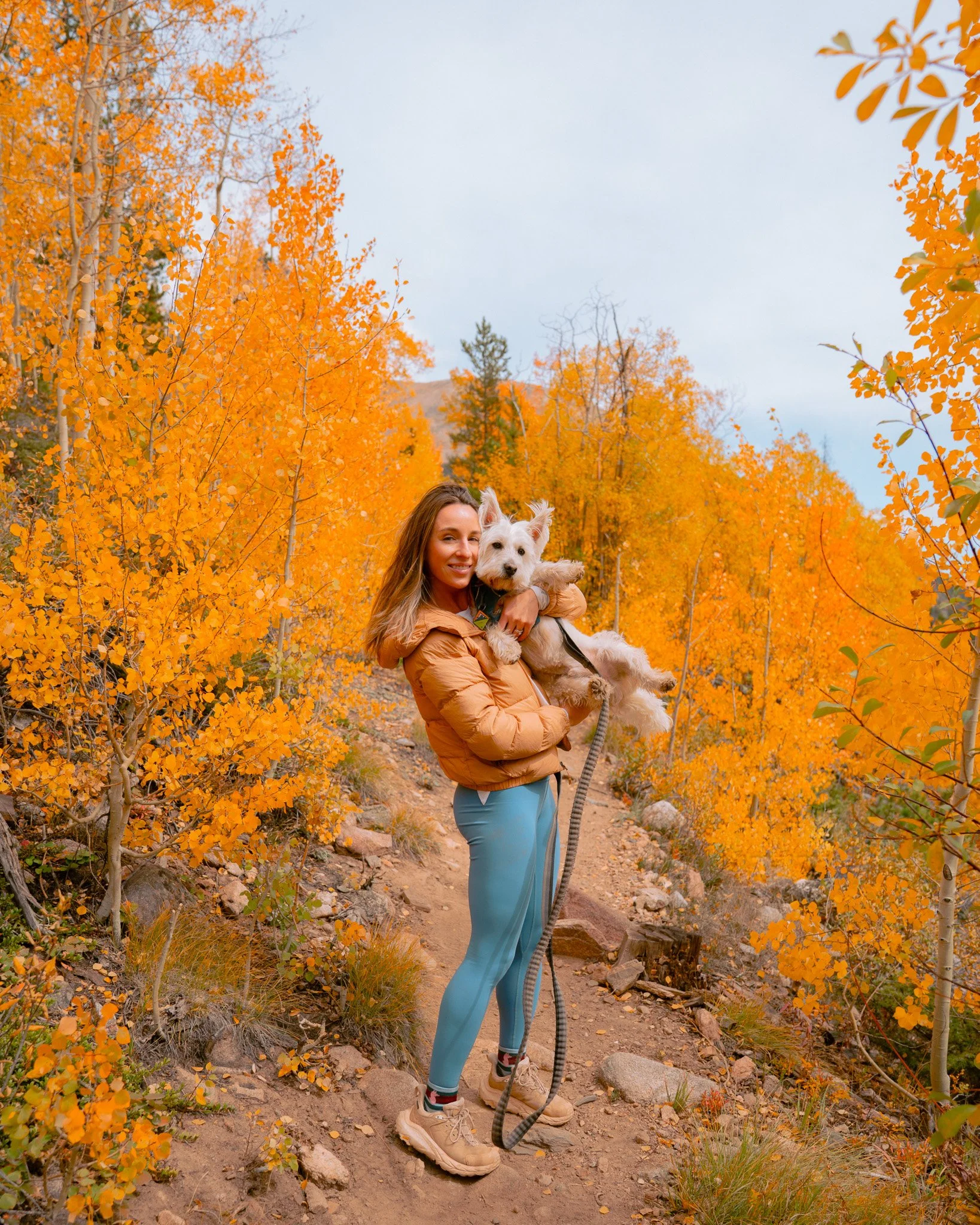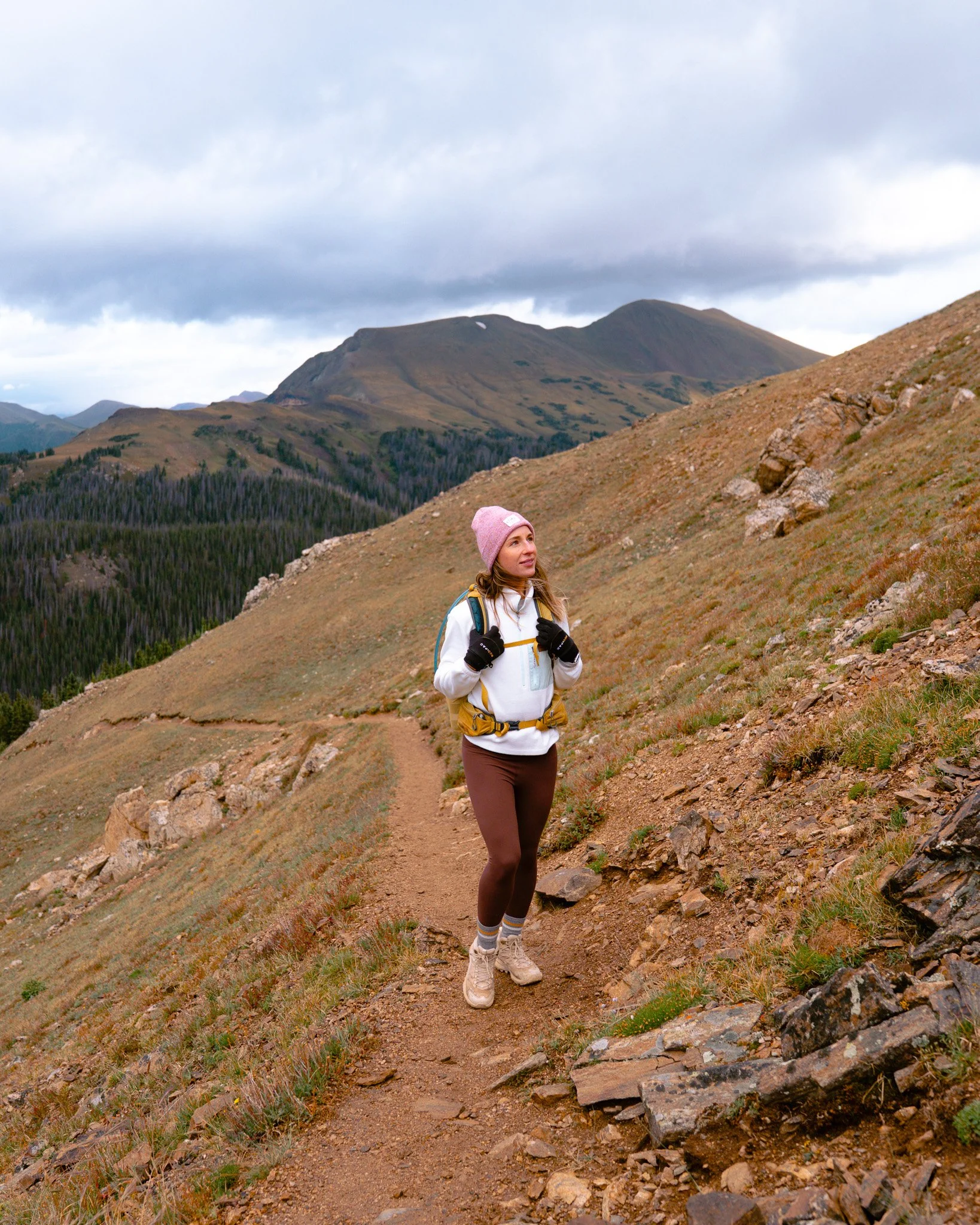Fall Hiking Essentials: The Best Gear & Clothing for Autumn Adventures
Fall hiking is one of the most rewarding times to be on the trail. The aspens here in Colorado turn golden, the mornings are crisp, and everyone’s trying to catch as much color as possible before winter sets in. But it’s also one of the hardest seasons to pack for. Temperatures swing from freezing at dawn to summer-like by afternoon, and sudden storms can still roll in without warning. The key to staying safe and comfortable is having the right fall hiking layers and gear.
Below, I break down the best fall hiking clothing and gear essentials, from base layers to outer shells, along with my favorite tried-and-true products that I personally use on the trails here in Colorado.
Best Tank Tops & Short-Sleeve Layers for Fall Hiking
Even as the air gets cooler, I still start most hikes with a lightweight tank or short-sleeve layer underneath my base or mid layer. It helps regulate body temperature, wicks sweat, and gives you the freedom to peel layers as the day warms up, which happens fast on sunny Colorado trails.
The best hiking tanks and short-sleeve tops for fall are breathable, moisture-wicking, with a built-in bra, and smooth enough to layer comfortably under long sleeves or fleeces. These are the tops that I wear on repeat throughout summer AND fall:
Best Fall Hiking Base Layers
A base layer is the first layer of clothing against your skin. Its job is to wick away sweat and regulate your temperature, keeping you dry in cool conditions. For fall hikes, always choose merino wool or synthetic fabrics — never cotton.
Best Fall Hiking Mid Layers
Your mid layer is your insulation layer — it traps heat while still letting moisture escape. Fleece is a great choice for breathability, while synthetic puffies give you extra warmth.
Best Insulated Jackets for Fall Hiking
An insulated jacket is perfect for early mornings, windy ridges, or long snack breaks. Even on sunny days, I always keep this layer in my backpack. Fall weather changes quickly above treeline or as the sun goes down (which happens earlier and earlier).
It’s always better to have that extra puffy in your backpack and not need it than leaving it at home and being cold. Plus, it doubles as cushion for some of my camera gear that’s often bouncing around in my backpack 😂
A high-quality down jacket is one of the most important investments you can make for cold-weather hiking, but only if you take care of it. Dirt, body oils, and compressed insulation can reduce warmth and loft over time.
Here’s how to keep it performing like new:
Wash it properly
Skip regular detergent as it can strip the natural oils from the feathers. Instead, use a specialized down cleaner like:
Wash on a gentle cycle with cold water, then tumble dry on low heat with a few clean tennis balls or dryer balls to re-fluff the down.
Restore its loft
If your jacket looks flat or lumpy, it’s probably lost its loft from being compressed too long. Gently fluff it in the dryer or by hand after washing. Down needs air circulation to stay warm and breathable.
Store it right
Never keep your down jacket squished in a stuff sack long-term. Hang it in a closet or store it loosely in a breathable cotton bag so it can maintain its shape and loft between seasons.
Best Fall Hiking Rain Jackets
Even if the forecast looks clear, every Colorado hiker knows how fast conditions can change in fall. One minute you’re basking in golden sunlight, and the next, you’re getting pelted with hail or hit by a cold gust at 12,000 feet. A good rain jacket is a must — it’s lightweight, waterproof, and just as effective for blocking wind as it is for keeping out rain.
Also, remember that even the best shells lose their waterproofing over time. Dirt, oils, and regular wear can cause water to “wet out,” meaning it soaks into the outer fabric instead of beading off.
Every few months or after several wet hikes, remember to re-waterproof your gear:
Clean it gently: Use a technical wash like Nikwax Tech Wash or Grangers Performance Wash.
Reapply DWR coating: Follow with Nikwax TX.Direct or Grangers Repel Spray to restore that water-beading finish.
Heat activate: Toss it in a low tumble dry for 15 minutes to help the treatment bond.
Waterproof gear is expensive, but it can last a long time with the proper care.
Best Bottoms for Fall Hiking
Whether you prefer leggings or traditional hiking pants, these are the best bottoms for fall hiking that balance comfort, function, and trail durability. If they’re leggings or pants, they NEED to pockets for my phone. I’m also a big fan of hiking in shorts as well, especially since the Front Range area of Colorado can stay warm well into late October.
Best Fall Hiking Boots
Merrell boots on an early fall hike in the Rockies
When it comes to fall hiking shoes, traction, waterproofing, and comfort are everything. Trails can start getting snowy and icy in higher elevations and then muddy in others, so you want footwear that grips well, keeps your feet dry, and supports your ankles on uneven terrain.
Fall is also the season when waterproof membranes and durable soles shine. Look for Vibram outsoles, waterproof leather or GORE-TEX liners, and midsoles that balance cushioning with stability.
Some people prefer trail runners or low-height boots. Almost all of these brands have low versions of their mid-height boot so it’s purely based on personal preference or the type of terrain. I like hiking in trail runners occasionally, but if I’m going on a longer hike in varied terrain then I prefer the extra ankle support.
Here are three of my favorite trail-tested hiking boots:
Best Fall Hiking Backpacks
Fall hiking means packing for two seasons at once. You’ll start bundled in fleece and end in a t-shirt, which means my backpack needs to fit those layers that you shed in addition to all my usual snacks, water, and camera equipment.
The best daypacks for fall hiking strike a balance between comfort, capacity (20–35L is the sweet spot), and smart organization. Look for breathable back panels, hip belts for weight distribution, and quick-access pockets.
I’m almost always reaching for either my Topo Designs or Gregory pack, but I love the Fjallraven 20L for shorter hikes:
In case of rain, don’t forget to grab a rain cover for your backpack! And, this is personal preference but for longer day hikes I love bringing a hydration bladder that’s at least 2L. The Gregory pack is compatible with hydration bladders but the others I’d stick two Nalgenes in the side pockets and that keeps me plenty hydrated.
Best Fall Hiking Accessories
When temperatures swing between frosty mornings and warm afternoons, these accessories are crucial for comfort on the trail. Even in the middle of the day, summits can be cold and windy and I’m personally so susceptible to cold fingers and ears!
If you’re going on a longer hike with a chance or rain, I’d also recommend packing an extra pair of socks. Literally nothing worse than cold wet feet on a hike!
Beanies
Socks
Miscellaneous Must-Haves for Fall Hiking
Once you’ve got your main pieces of gear dialed in, you can fine tune all of the random additional items that you need to enjoy hiking on the trail. Here are some of the things I never hike without:
Final Thoughts
Fall hiking can be unpredictable but also gorgeous, and that’s part of what makes it so special. The mornings start cold, the afternoons feel like summer again, and the weather never fully makes up its mind. But with the right gear, you can be ready for all of it!
Whether you’re chasing golden aspens in Colorado or just exploring your local trails, fall is one of the best times to hike. The crowds start to thin out, the air feels fresh, and every trail looks like an explosion of gold.
So grab your jacket and get out there — before the snow moves in.
This post contains affiliate links, meaning I earn a small commission if you make a purchase through them, at no extra cost to you. Thank you for your support!


